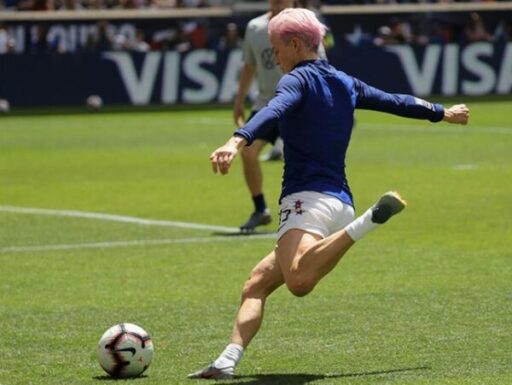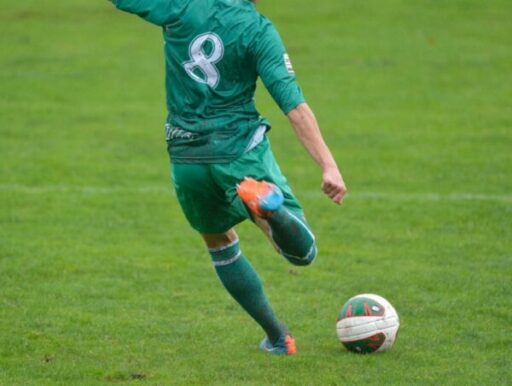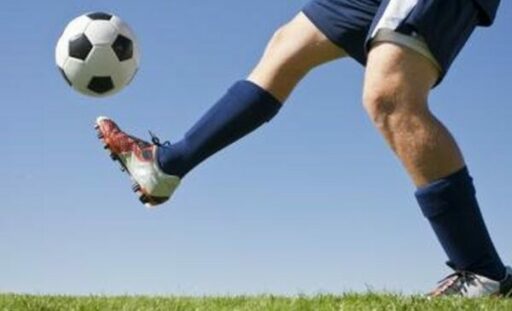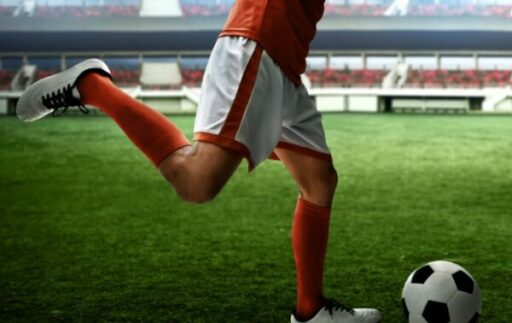Soccer is a sport loved by millions around the world, and one of the most exciting moments in any match is when a player kicks the ball far down the field towards the opponent’s goal. The ability to kick a soccer ball far is not only impressive, but it can also be a valuable asset for players on the field. Whether you’re a striker aiming to score a goal or a defender trying to clear the ball from your side of the field, knowing how to kick the ball far can give you a significant advantage over your opponents. In this article, we’ll discuss the key techniques and habits you need to develop to kick a soccer ball far, so you can improve your game and become a more effective player.
Proper Stance and Foot Placement
- The Proper Stance for Kicking a Ball Far
- Stand with feet shoulder-width apart
- Place non-kicking foot slightly behind the ball
- Keep knees slightly bent for balance and stability
- Lean slightly over the ball to generate power
- How Foot Placement Affects the Distance of the Kick
- Position your foot at a 90-degree angle to the ball
- Use the instep or the laces of the shoe to strike the ball
- Place your foot low on the ball to generate lift and height
- Follow through with the kicking foot to maximize power
- Common Mistakes to Avoid
- Avoid leaning back or standing too upright, as this can reduce power and accuracy
- Do not place your foot too close or too far away from the ball, as this can affect the angle of the kick and reduce distance
- Avoid locking your knees or standing too rigidly, as this can limit your range of motion and reduce power
By following the proper stance and foot placement techniques described above, you can generate more power and accuracy when kicking a soccer ball.
Power Generation Techniques
- Different Techniques for Generating Power for a Kick
- Hip rotation: twisting the hips before making contact with the ball to generate power
- Leg swing: swinging the leg back and then forward in a fluid motion to generate momentum
- Arm swing: swinging the arms back and then forward to generate momentum and balance
- Plant foot stability: maintaining a stable plant foot to ensure balance and power transfer to the kicking foot
- Exercises and Drills to Develop Power Generation Techniques
- Medicine ball twists: twisting the torso with a medicine ball to develop hip rotation and core strength
- Resistance band drills: using resistance bands to practice leg and arm swings for power generation
- Cone drills: setting up cones and practicing kicks while moving around them to develop balance and stability
- Plyometric exercises: incorporating explosive jumps and hops into training to develop leg strength and power
By practicing these power generation techniques through targeted exercises and drills, you can develop the strength and muscle memory needed to kick a soccer ball far with ease.
Striking the Ball with the Right Surface
- How the Surface of the Foot Affects Distance and Accuracy
- The inside of the foot is ideal for short passes and close-range shots
- The outside of the foot can be used for curving the ball or for more finesse shots
- The instep and laces are ideal for long, powerful shots
- Advantages of Using the Instep or Laces for Far Kicks
- The instep provides a larger surface area for striking the ball, allowing for greater accuracy
- Using the laces provides a more focused, concentrated strike that generates more power
- Kicking with the instep or laces allows for more backspin on the ball, which can help it travel farther and with greater accuracy
- Tips for Proper Instep and Laces Kicking Technique
- Place the non-kicking foot beside the ball and aim at your target
- Make contact with the ball using the middle or top of the foot for the instep kick, and the top of the foot near the ankle for the lace kick
- Follow through with the kicking foot towards your target to maximize power and accuracy
By striking the ball with the right surface of the foot and using proper technique, you can increase the distance and accuracy of your kicks, making you a more effective player on the field.

Wind-Up and Follow Through
- Importance of Proper Wind-Up and Follow-Through
- Proper wind-up and follow-through are essential for generating maximum power and distance in a kick
- They help to create momentum that can be transferred to the ball
- They also help to maintain balance and control during the kick
- How Momentum Adds Distance to a Kick
- The momentum generated during the wind-up allows the player to build up potential energy
- The follow-through transfers this energy to the ball, adding power and distance to the kick
- A fluid, continuous motion from wind-up to follow-through maximizes the amount of momentum transferred to the ball
- Tips for Proper Wind-Up and Follow-Through Technique
- Wind up the kicking leg by swinging it back behind the body, twisting the hips and shoulders in the opposite direction
- As the leg comes forward, make contact with the ball at the optimal point with the instep or laces
- Follow through with the kicking leg, extending it towards the target, and landing on the non-kicking foot
By mastering the wind-up and follow-through techniques, players can generate greater momentum and power, adding distance and accuracy to their kicks.

Angle of Approach
- Optimal Angle of Approach for a Powerful Kick
- The optimal angle of approach for a powerful kick is about 45 degrees
- This angle allows the player to strike the ball with the instep or laces and generate maximum power and distance
- The angle may vary slightly depending on the distance to the ball and the position of the target
- How Angle of Approach Affects Trajectory and Distance of the Ball
- Approaching the ball from too steep of an angle can cause the ball to travel higher than intended
- Approaching the ball from too shallow of an angle can cause the ball to stay low and lose power
- An optimal angle of approach allows the ball to travel in a straight, direct path towards the target
- Tips for Approaching the Ball at the Right Angle
- Anticipate the trajectory of the ball and approach it at the optimal angle
- Take a few quick steps towards the ball to build momentum
- Plant the non-kicking foot beside the ball and position the kicking foot for optimal contact
By approaching the ball at the right angle, players can ensure that their kicks travel in a straight, direct path towards the target with maximum power and distance.
Strength and Conditioning
- Role of Strength and Conditioning in Developing a Powerful Kick
- Developing leg strength and power is essential for kicking a soccer ball far
- Regular strength and conditioning exercises can improve leg strength, speed, and explosiveness
- Strong leg muscles also help players maintain proper form and technique throughout the kick
- Tips for Exercises to Improve Leg Strength and Kicking Power
- Squats: a classic exercise that strengthens the quads, hamstrings, and glutes
- Lunges: a great exercise for building leg strength and balance
- Plyometric jumps: jumping exercises that develop explosiveness in the legs
- Calf raises: a simple exercise that targets the calf muscles, which are essential for kicking power
- Resistance band exercises: using resistance bands to provide resistance and improve leg strength
- Importance of Proper Form During Strength and Conditioning Exercises
- Maintaining proper form during exercises is essential for preventing injury and maximizing results
- Focus on good posture, alignment, and full range of motion during exercises
- Gradually increase weight, reps, and sets as strength improves
By incorporating regular strength and conditioning exercises into their training routine and focusing on proper form and technique, players can improve their leg strength and power, leading to more powerful and accurate kicks on the field.

Practice and Consistency
- Importance of Consistent Practice in Developing a Powerful Kick
- Like any skill, kicking a soccer ball far requires consistent practice and repetition to develop muscle memory
- Regular practice also helps players build confidence in their abilities
- Without consistent practice, kicking skills may deteriorate over time
- Tips for Incorporating Kicking Practice into Regular Training Sessions
- Set aside dedicated time for kicking practice during training sessions
- Practice a variety of kicks, including short passes, long-range shots, and volleys
- Incorporate drills that focus on power generation, foot placement, and follow-through technique
- Use cones or targets to simulate game situations and improve accuracy
- Work with a partner or coach to receive feedback and make corrections to technique
- Strategies for Maintaining Consistency in Practice
- Set realistic goals for improvement and track progress over time
- Create a schedule or routine for regular practice sessions
- Mix up training drills and exercises to keep practice sessions engaging and challenging
- Practice in different environments, such as on grass, turf, or indoors, to improve adaptability
By consistently practicing kicking techniques and incorporating targeted drills into training sessions, players can develop the muscle memory, confidence, and skills needed to kick a soccer ball far with ease.
Mental Preparation
- Role of Mental Preparation in Achieving a Powerful Kick
- Mental preparation is essential for developing confidence, focus, and the right mindset for kicking a soccer ball far
- It helps players overcome anxiety and self-doubt, allowing them to perform at their best
- Mental preparation can also help players visualize the kick and improve technique and accuracy
- Tips for Visualization and Mental Training Exercises to Improve Kicking Technique and Confidence
- Visualization: imagine yourself performing the perfect kick in your mind, focusing on the key techniques and movements
- Positive affirmations: repeat positive statements to yourself, such as “I am a skilled kicker” or “I have the power to kick the ball far”
- Breathing exercises: deep breathing can help calm the mind and reduce anxiety before a kick
- Focus training: practice focusing on a single point or target, blocking out distractions and maintaining concentration during the kick
- Goal setting: set specific, measurable goals for improvement, and track progress over time
- Strategies for Incorporating Mental Preparation into Training
- Dedicate time for mental preparation exercises during training sessions
- Encourage players to practice mental preparation techniques on their own outside of training
- Work with a sports psychologist or mental coach to develop a personalized mental preparation plan
By incorporating mental preparation exercises into their training routine, players can develop the mental focus, confidence, and skills needed to perform their best on the field and kick a soccer ball far with ease.
Conclusion
Kicking a soccer ball far is an impressive skill that can give players a significant advantage on the field. In this article, we’ve discussed the key techniques and habits you need to develop to kick a soccer ball far, including proper stance and foot placement, power generation techniques, striking the ball with the right surface, wind-up and follow-through, angle of approach, strength and conditioning, practice and consistency, and mental preparation. By incorporating these tips and techniques into your training routine, you can improve your kicking skills and become a more effective player on the field. Remember to maintain proper form, practice consistently, and stay mentally focused and confident, and you’ll be kicking the ball farther than ever before in no time.

